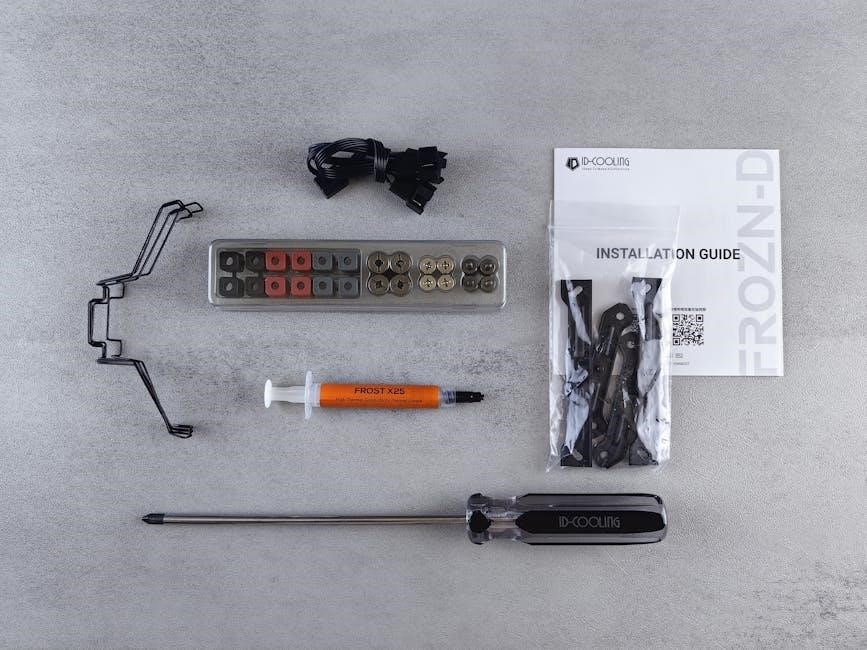The Honeywell TH5220D1003 is a non-programmable digital thermostat designed for simplicity and efficiency. It offers precise temperature control and compatibility with various heating and cooling systems, ensuring optimal performance and ease of use for homeowners.
1.1 Overview of the Honeywell TH5220D1003 Model
The Honeywell TH5220D1003 is a non-programmable digital thermostat designed for straightforward operation and energy efficiency. It features a backlit display for easy readability and is compatible with a wide range of heating and cooling systems, including single-stage HVAC systems. This model is ideal for homeowners seeking a reliable, user-friendly thermostat without advanced scheduling capabilities. Its compact design and intuitive interface make it a popular choice for installations where simplicity is prioritized. The TH5220D1003 supports 24V systems and is dual-powered, offering flexibility for various household configurations. It ensures precise temperature control, optimizing comfort and energy savings.
1.2 Key Features of the Thermostat
The Honeywell TH5220D1003 boasts a user-friendly interface with a backlit LCD display, ensuring easy readability in any lighting conditions. It offers precise temperature control with a range of 40°F to 90°F, providing consistent comfort. This thermostat is compatible with single-stage heating and cooling systems, including heat pumps. It features dual-power options, operating on either battery or hardwiring, enhancing installation flexibility. The TH5220D1003 also includes basic temperature hold functionality, allowing temporary adjustments without altering the overall settings. Its compact design and durable construction make it a reliable choice for homeowners seeking a straightforward, efficient thermostat solution.
Pre-Installation Requirements
Ensure compatibility with your HVAC system, verify wiring configurations, and prepare necessary tools. Always turn off power to the system before starting installation for safety.
2.1 Compatibility Check for Heating/Cooling Systems
Verify that the Honeywell TH5220D1003 is compatible with your system. Check the HVAC type, such as gas, oil, or electric heat, and ensure it supports the same staging. For heat pumps, confirm the correct configuration, like 1 heat/1 cool. The thermostat is designed for 2-wire or 4-wire systems, so match your wiring setup. Ensure the system voltage matches the thermostat’s requirements, typically 24V AC. Refer to the user manual or manufacturer’s guidelines for specific compatibility details to avoid installation issues.
2.2 Tools and Materials Needed for Installation
To install the Honeywell TH5220D1003, gather essential tools: a screwdriver (Phillips and flathead), wire strippers, pliers, and a voltage tester. Ensure you have a ladder for safe access and a pencil for marking wires. Materials needed include 18- to 22-gauge thermostat wire, wall anchors, and screws for mounting. Shielded cable is optional but recommended for noise reduction in certain setups. Always refer to the thermostat’s manual for specific requirements, as some systems may need additional components. Having these tools and materials ready ensures a smooth and efficient installation process.

Wiring and Connections
Understanding the wiring diagram is crucial for proper installation. Ensure all wires are connected to the correct terminals as per the HVAC system’s specifications for safe operation.
3.1 Understanding the Wiring Diagram
Understanding the wiring diagram for the Honeywell TH5220D1003 is essential for a successful installation. The diagram outlines the connections between the thermostat and your HVAC system. Each wire corresponds to a specific function, such as power, heating, cooling, and fan control. Ensure you identify the correct terminals, typically labeled R, W, Y, G, and C, to connect the wires properly. Misconnecting wires can lead to system malfunctions or safety hazards. Refer to the manufacturer’s guide for detailed instructions and double-check your connections before powering on the system. Proper wiring ensures efficient and safe operation of your thermostat and HVAC system.
3.2 Connecting the Thermostat to the HVAC System
Connecting the Honeywell TH5220D1003 to your HVAC system requires careful attention to wire placement and system compatibility. Ensure the HVAC system is powered off before starting. Match the wires from your HVAC system to the corresponding terminals on the thermostat, referencing the wiring diagram for accuracy. Secure all connections firmly to avoid loose wires, which can disrupt operation. Once all wires are connected, turn the power back on and test the system to confirm proper functionality. Proper connections ensure safe and efficient operation of both the thermostat and HVAC system, preventing potential malfunctions or safety hazards.

Installation Steps
Mount the thermostat, connect wires to the HVAC system, and power on the unit. Test functionality and ensure all settings are configured properly.
4.1 Mounting the Thermostat on the Wall
4.2 Configuring the Thermostat Settings
After mounting, power on the thermostat using batteries or the connected power source. Navigate to the settings menu to configure basic options. Set the time and date, then select your HVAC system type (e.g., gas, oil, or electric heat with AC, or heat pump). Choose the appropriate system configuration in the installer setup mode. Set your desired temperature range, ensuring it aligns with your comfort preferences. Adjust the temperature differential to minimize frequent heating or cooling cycles. Finally, review and save all settings to ensure proper operation. Refer to the wiring diagram if adjustments are needed for system compatibility.
4.3 Setting Up the Temperature Range
After configuring the basic settings, set your desired temperature range for heating and cooling. Navigate to the temperature settings menu and adjust the minimum and maximum temperatures to suit your comfort needs. Typically, set the heating range between 40°F to 90°F and cooling between 50°F to 99°F. Use the up/down arrows to adjust the setpoint temperatures. Ensure the temperature differential is set correctly to avoid frequent system cycles. Save your settings to apply the temperature range. This step ensures your HVAC system operates efficiently and maintains consistent comfort levels in your home. Proper setup prevents extreme temperature fluctuations and optimizes energy use.
Programming and Configuration
Configure the thermostat by setting the time, date, and scheduling options. Program heating and cooling schedules to match your daily routine for energy efficiency and comfort.
5.1 Setting the Time and Date
To set the time and date on the Honeywell TH5220D1003, navigate to the clock settings using the menu button. Use the up or down arrows to adjust the hour, minute, and AM/PM options. Once the time is set, select the correct date. Ensure accuracy to maintain schedule integrity. Some models may require setting the time manually, while others sync automatically if connected to a power source. Proper time and date settings are crucial for accurate temperature scheduling and energy management;
5.2 Configuring Heating and Cooling Schedules
Configuring heating and cooling schedules on the Honeywell TH5220D1003 involves setting specific temperature levels for different times of the day. Use the menu button to access the schedule settings. Select the desired period (e.g., morning, afternoon) and adjust the temperature using the up or down arrows. Ensure the schedule aligns with your daily routine for energy efficiency. If the thermostat is connected to a power source, it may automatically save your settings. Proper scheduling helps maintain consistent comfort while optimizing energy usage. Always review and confirm your settings before finalizing them.
5.3 Adjusting Advanced Settings (Optional)
The Honeywell TH5220D1003 allows users to fine-tune settings for enhanced performance. Access the advanced menu by pressing the menu button and navigating to “Advanced Settings.” Adjust options like temperature differential, which determines how much the system deviates from the set temperature before activating. Enable features like keypad lock to prevent accidental changes or set a filter reminder for maintenance alerts. These settings can be customized to optimize energy usage and comfort. Refer to the user manual for detailed instructions on each feature. Adjusting these settings ensures the thermostat operates precisely according to your preferences.

Troubleshooting Common Issues
Troubleshooting the Honeywell TH5220D1003 involves checking power supply, wiring connections, and temperature settings. Ensure the thermostat is powered on and properly connected to the HVAC system to resolve operational issues effectively.
6.1 Resolving Power Issues
If the Honeywell TH5220D1003 thermostat displays a blank screen or is unresponsive, it may indicate a power issue. First, ensure the thermostat is properly powered. For battery-powered models, check that the batteries are installed correctly and not depleted. If the thermostat is hardwired, verify that the power source is active and functioning. Check for loose or disconnected wires at the thermostat and HVAC system connections. If issues persist, try resetting the thermostat by removing the batteries or switching off the breaker controlling the HVAC system. Ensure the HVAC system itself is powered on and set to an active mode (e.g., Heat or Cool).
6.2 Fixing Incorrect Temperature Readings
If the Honeywell TH5220D1003 thermostat displays incorrect temperature readings, ensure it is properly calibrated. First, check that the thermostat is installed in an area with consistent temperature, away from drafts, direct sunlight, or appliances that generate heat. Next, clean the thermostat’s sensor gently with a soft cloth to remove any dust or debris. If issues persist, recalibrate the temperature sensor by pressing and holding the “Menu” button until “Calibrate” appears, then follow the on-screen instructions to adjust the temperature offset. Ensure the thermostat is level on the wall to maintain accurate readings. If problems continue, reset the thermostat by removing the batteries or switching off the power supply temporarily. After restarting, verify the temperature accuracy by comparing it with a reliable thermometer. If the issue remains unresolved, refer to the user manual or contact Honeywell support for further assistance. Always ensure the thermostat is powered correctly and configured according to the manufacturer’s guidelines. Regular maintenance and updates can help prevent such issues, ensuring the thermostat operates at peak performance. By following these steps, you can restore accurate temperature readings and maintain optimal comfort in your home.
6.3 Addressing Communication Errors
Communication errors with the Honeywell TH5220D1003 thermostat can occur due to wiring issues or system incompatibility. First, ensure all wires are securely connected to the correct terminals. Verify that the thermostat is properly powered and that the HVAC system is compatible. If the thermostat fails to communicate with the system, reset the thermostat by removing the batteries or switching off the power supply temporarily. After restarting, test the communication by running a heating or cooling cycle. If issues persist, check for loose connections or damage to the wiring. Ensure the thermostat is configured correctly for your HVAC system type. If problems continue, consult the user manual or contact Honeywell support for assistance. Regularly updating the thermostat’s software, if applicable, can also resolve communication errors. Always follow the manufacturer’s troubleshooting guidelines to restore proper functionality. By addressing these potential issues, you can ensure seamless communication between the thermostat and your HVAC system. Proper communication is essential for maintaining efficient temperature control and overall system performance. If the problem persists, it may be necessary to consult a professional for further diagnosis and repair.

Maintenance and Upkeep
Regular maintenance ensures the Honeywell TH5220D1003 thermostat operates efficiently. Clean the screen gently with a soft cloth and replace batteries annually. Check wiring connections periodically to prevent issues.
7.1 Cleaning the Thermostat
Cleaning the Honeywell TH5220D1003 thermostat is essential for maintaining its functionality. Use a soft, dry cloth to gently wipe the display and exterior. Avoid harsh chemicals or liquids, as they may damage the screen or internal components. Regularly cleaning prevents dust buildup, ensuring accurate temperature readings and smooth operation. For stubborn smudges, dampen a cloth with distilled water, but ensure it’s thoroughly dried to prevent moisture damage. This simple maintenance step helps preserve the thermostat’s performance and longevity, keeping your home climate control reliable and efficient.
7.2 Replacing Batteries
Replacing the batteries in your Honeywell TH5220D1003 thermostat is a straightforward process. Ensure the thermostat is turned off before starting. Remove the old batteries from the compartment, located on the back or side of the device. Insert two new AA alkaline batteries, matching the polarity indicated in the compartment. Avoid mixing old and new batteries to maintain consistent power. After replacing, close the battery compartment securely. If the thermostat loses programming during a power outage, reprogramming may be necessary. Regular battery replacement prevents operational issues and ensures reliable temperature control. Always test the thermostat after replacing batteries to confirm proper function.
7.3 Updating Software (if applicable)
The Honeywell TH5220D1003 thermostat does not typically require software updates, as it is a non-programmable model. However, if updates are necessary, refer to the manufacturer’s instructions or contact Honeywell support. Ensure the thermostat is powered off before attempting any updates. Use a compatible device or computer to download and install the latest firmware from Honeywell’s official website. Follow the step-by-step guide provided with the update to avoid any issues. After updating, test the thermostat to ensure all functions operate correctly. Regular software maintenance ensures optimal performance and compatibility with your HVAC system.
Safety Precautions
Always turn off power before installation to avoid electrical hazards. Ensure the thermostat is installed in a well-ventilated area, away from direct sunlight and moisture. Never install near open flames or sparks. Follow local electrical codes and manufacturer guidelines for a safe installation.
8.1 Avoiding Common Installation Mistakes
One of the most common mistakes during installation is not turning off the power supply before starting, which can lead to electrical shocks or damage to the thermostat. Another error is improperly connecting the wires, which can result in system malfunctions. Ensure the thermostat is mounted level and in a location with good air circulation to avoid inaccurate temperature readings. Additionally, using incorrect wire gauges or ignoring manufacturer-recommended settings can compromise performance. Always double-check wiring connections and follow the installation guide step-by-step to prevent these avoidable issues and ensure a smooth setup.
8.2 Ensuring Proper Ventilation
Proper ventilation is crucial for accurate temperature readings and efficient system operation. Install the thermostat in an area with good air circulation, avoiding direct sunlight or drafts. It should be placed about 5 feet above the floor to ensure it reflects the average room temperature. Do not install it near heating vents, radiators, or air conditioning units, as this can cause inaccurate readings. Additionally, keep the thermostat away from areas with high humidity or moisture. Regularly clean the device to ensure good airflow and prevent dust buildup, which can interfere with its performance and reliability.

Manufacturer Recommendations
Honeywell recommends following their official installation guidelines for the TH5220D1003 to ensure optimal performance and warranty validity. Refer to the provided user guide for detailed instructions and support information.
9.1 Honeywell’s Official Installation Guidelines

Honeywell’s official guidelines for the TH5220D1003 emphasize proper installation to ensure optimal performance. Start by verifying system compatibility and using 18- to 22-gauge thermostat wire. Mount the thermostat 5 feet above the floor in an area with good air circulation, avoiding direct sunlight or windows. Follow the wiring diagram carefully to connect the thermostat to your HVAC system. Ensure all connections are secure to prevent errors. After installation, configure the settings according to your heating and cooling needs. Refer to the user guide for detailed step-by-step instructions and troubleshooting tips. Proper setup ensures reliability and maintains warranty validity.
9.2 Warranty and Support Information
The Honeywell TH5220D1003 thermostat is backed by a 1-year limited warranty covering manufacturing defects in materials and workmanship. For warranty claims, contact Honeywell’s customer service or visit their official website. Proper installation following the guidelines is essential to maintain warranty validity. Honeywell also provides dedicated support through their website, including user manuals, troubleshooting guides, and FAQs. For assistance, users can call Honeywell’s customer support or access online resources for detailed help. Ensure to register your product for full warranty benefits and timely support.
Completing the Honeywell TH5220D1003 installation ensures precise temperature control and energy efficiency. Follow final checks to confirm everything works smoothly for optimal performance and comfort.
10.1 Final Checks Before Operation
After installation, perform final checks to ensure everything functions correctly. Verify all wiring connections are secure and match the wiring diagram. Test the HVAC system by running a heating and cooling cycle to confirm proper operation. Check that the thermostat display is active and responsive. Ensure the temperature setpoints are accurately set and that the system turns on/off as expected. Also, confirm the thermostat’s location is level and in an area with good air circulation. Finally, review the user settings to ensure they align with your preferences. A successful final test ensures your Honeywell TH5220D1003 is ready for reliable performance.
10.2 Tips for Optimal Thermostat Performance
To maximize the performance of your Honeywell TH5220D1003 thermostat, ensure it is installed in an area with consistent temperatures, away from direct sunlight or drafts. Regularly clean the thermostat to maintain accuracy and responsiveness. Check and replace batteries as needed to prevent interruptions. Adjust temperature settings seasonally to optimize energy efficiency. Refer to the user guide for specific maintenance recommendations. By following these tips, you can ensure your thermostat operates efficiently, providing consistent comfort and energy savings throughout the year.
